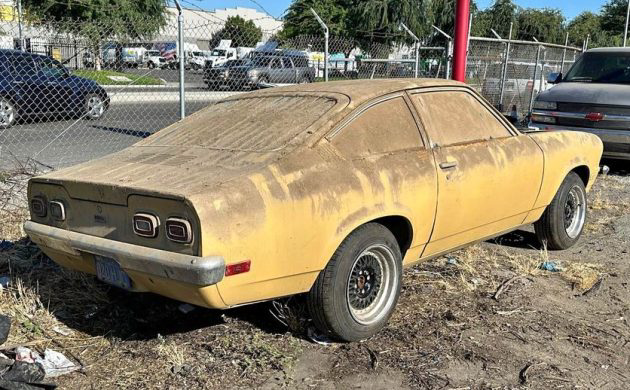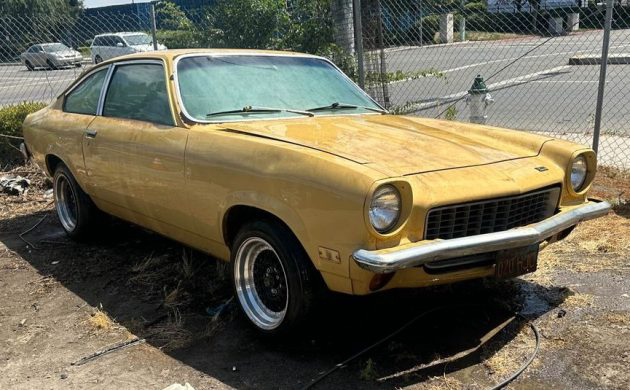45k Original Miles? 1971 Chevrolet Vega
Post-war American buyers grew up on a diet of larger cars, and the sales results through the 1950s and 1960s confirm this. However, when subcompact models from Europe and Japan gained traction in the local market, American manufacturers were caught flat-footed. They didn’t have the experience to produce cars that foreign manufacturers had developed into a virtual art form, and early attempts with the Ford Pinto and Chevrolet Vega lacked the build quality and engineering sophistication of the competition. Therefore, many of those cars made their final journey to the scrapyard decades ago. This 1971 Chevrolet Vega is an exception to that rule and is a two-owner classic with a claimed 45,000 miles on the clock. It appears to be solid and complete, making it ideal for anyone seeking a project candidate. The seller has listed the Vega here on Facebook Marketplace in Fresno, California. The seller set their price at $5,500, meaning that it undoubtedly falls into the affordable category.
I’m not going to sugar-coat this, because the Chevrolet Vega’s reputation was damaged early by major quality control issues. Apart from mechanical shortcomings, the Vega became renowned for severe rust problems. However, our feature car, which rolled off the line in 1971, seems to have avoided those problems. The panels have a few minor bumps and the Code 52 Yellow paint is faded, but I am impressed by the lack of visible penetrating rust. Of course, we can’t see this classic’s underside, but if it has spent its life in its current location, the dry climate may have protected it from crumbling steel. A few trim pieces require TLC, but the glass is clean. Overall, whipping this Vega’s panels and paint into shape would appear to be straightforward. That might make it ideal for a first or DIY project build.
The same climate that has protected this Vega’s steel has exacted a high toll on the interior vinyl and plastic. It remains serviceable, but at least a partial retrim is required to lift it to a presentable state. The process will include new seatcovers and a carpet set, but since this is the only interior image, it is hard to determine what other parts might be required. The seller supplies no engine photos but confirms that this Vega features a 140ci four-cylinder engine, teamed with a four-speed manual transmission. With 90hp and 136 ft/lbs of torque on tap, the Vega wasn’t lightning fast. However, that was never the aim of the exercise, because this subcompact was designed to return excellent fuel economy figures. It succeeded at that goal, although these engines suffered early reliability issues that tarnished the Vega’s reputation until production ended in 1977. This was even though Chevrolet continued development on the powerplant to eliminate the problems. The seller doesn’t state when this classic last fired a shot in anger, but I suspect a few years may have passed since that day. They indicate an odometer reading of 45,000 miles without mentioning verifying evidence. Revival in the car’s original form might be possible, although I have seen these featuring an array of engine transplants that improve performance and reliability. That is an option that some potential buyers might view favorably.
My observation about American manufacturers focusing on larger models was in no way a criticism because it demonstrated that companies had developed an in-depth understanding of buyer tastes. Nobody in the 1960s could have predicted the extraordinary rise of the foreign subcompact, and the extensive experience European and Japanese car makers possessed undoubtedly gave them an advantage as the market niche developed in North America. Companies like Ford and General Motors faced a steep learning curve, and failures were almost inevitable. The Vega demonstrated this, but any that have survived to this day deserve respect as pioneers in their field. This 1971 example is unlikely to command a huge price in the future, but its originality and seeming lack of rust make it deserving of restoration. Is this one that you would consider tackling?
Auctions Ending Soon
 2002 Subaru Impreza WRXBid Now2 days$333
2002 Subaru Impreza WRXBid Now2 days$333
 1975 Chevrolet Corvette ConvertibleBid Now2 days$4,000
1975 Chevrolet Corvette ConvertibleBid Now2 days$4,000
 1964 Ford F-100 Camper CustomBid Now2 days$2,000
1964 Ford F-100 Camper CustomBid Now2 days$2,000
 2006 Jeep Wrangler SportBid Now4 days$10,500
2006 Jeep Wrangler SportBid Now4 days$10,500
 1974 Datsun 260ZBid Now6 days$460
1974 Datsun 260ZBid Now6 days$460





Comments
I happened to like the Vega. I had a friend with a yellow GT( oh boy) and with strict oil changes and never overheated in the North Pole( one of the biggest Vega killers was overheating), it was a reliable, fun little car. Thing was, Americans, like my old man, were used to the 455s, and the poor Vega( and Pinto) had some big shoes to fill. Plus that cam belt thing, I hold fast the belief why the Gremlin was so successful, it featured mechanicals we were used to. I couldn’t imagine anyone that would restore this, maybe as a resto-mod be pretty cool, but honestly, when was the last time you saw a Vega, of ANY kind, on the road?
They were good looking cars with a running gear that would get them through the ’70s gas crisis. Went through that mess and it wasn’t fun. Neighbor had one that spent more time not running than running which dove him nuts and had him wishing he’d bought a gas guzzler.
This was the best looking body for the Vega its more likely 145k miles but if its clean it would make for a fun hotrod to build
Wow, loaded with 4-speed, deluxe interior and air. These were good looking cars with the almost Camaro styling.
Hopefully someone will polish this turd. I’d prefer that it stay as stock as possible for posterity.
Living in Buick City watching these rust away in single digit years shocked my 12ish year old mind.
It’s a ‘73 based on the filler plate behind the front bumper.
‘Nobody in the 1960s could have predicted the extraordinary rise of the foreign subcompact’
It happened in the late 50s. Foreign makes were taking 10% of the market. Rambler and Studebaker’s Lark made inroads as well.
The industry got lax and lazy in the late sixties and had allowed it’s compacts and intermediates to morph into 3000 lb pigs…
Quite easy to predict a rejection of Detroit sloth by 1970, with VW’s Beetle selling 100s of thousands of units a year, Renault #2, Toyota Corona and Datsun offerings growing in sales every year.
But yeah. I love the design of the Vega and even had one as a Driver’s Ed vehicle, a pretty forest green metallic one.
Gas mileage would be considered poor if you factor the miles car was powered by the tow truck.
The last time I saw a Vega that looked that solid and rust free was probably when the car was just a few weeks old.
I don’t doubt that Vegas had quality control and dependability issues, but the major problem was a fundamental design flaw. The teflon coated aluminum cylinders just didn’t stand up to the rigors of everyday use and abuse. I had a ‘72 Kammback. It was a nice little car- however the original engine failed before 50k, and the factory warranty replacement lasted about 18k.
My uncle had a boat with a Mercruiser 140 inboard. Vega engine. Failed early on, in spite of fastidious care. He was told nothing could be done with it because the whiz-bang Teflon coating had failed. My Dad found some cylinder sleeves the correct diameter, and had them cut to the proper length. Bored the cylinder to fit the sleeve- Viola’! Problem solved. This was early on when the experts still claimed that they couldn’t be sleeved. Later, that became the go-to solution.
Nice find for someone – else.
It might take a few lessons, but then voila! They’ll be able to play a viola!
No one is going to spend the kind of money to restore the interior, get it running, all the suspension, fuel and brake lines for a Vega.
Nice looking small car, but plagued with a crappy motor! An Asian friend commented once about an attractive girl that had a bad personality. He called her “ good body, bad motor”!
Someone please wash this car.
My prediction is that a small block chevy engine will be what fills the engine bay in this car. These are decent looking cars and kits are available to put many different engines in one which makes them attractive to people who might not have tools or skills to build a hotrod. I always thought V8 Vegas were a good starter hot rod.
I had two of these,one 400 sbc and one 454 bbc. The pre ’74 were the best looking but had small ball joints. Small blocks were good street setup up to a certain hp. Mustang rack made for more room in the engine compartment and pretty easy swap. BBC took a lot of fabricating. I’d run a small block in it
I think with a 454 in this car, you’d need big ball (s joints). Showing myself out now
bt
Best friend’s dad had a Kammback that they bought new in ’74. By the time ’79 rolled around it had maybe 50k on it and he was putting a quart of used motor oil in every couple of days for his 15 mile (maybe) round trip commute to IBM. Mosquito control car. Ended up painting it IBM mainframe blue with a brush and roller (wonder where the paint came from?) and you had to lift the doors to get them to close.
This one looks prime for a small block and a 5 speed. Would make a fun little hot rod.
Wow, it’s wild that this Vega has lasted over 50 years. I had a used (abused) 71′ Vega GT in 1980. I paid $175 for it. Yep, $175 !–Talked my neighbor down from $200. It was orange with the white stripes .The guys I worked with would joke “Check the gas , Fill the oil ?) I used 20w50 oil that we used on our Detroit Diesels back then. The car would burn a quart about every 90 miles. After almost 8K Miles, I sold it to a kid in my town for $125. He wanted it for the GT wheels. The most valuable thing in that POS was the Hurst shift knob. Yep, I had to give up that shift knob as part of the sale ! Gotta’ love it
A guy I knew had a new 73 Camaro Z28 in dark metalic blue. His wife bought a brand new dark blue Vega to match. They looked good together I always thought they reminded me a lot of the Camaro styling which was a really good thing in my book. Lets just say….. The Camaro outlived the Vega unfortunately. It was a good idea but rushed into production too quickly.
This is the body style to have , engine, trans, diff and most other mechanical parts need to go to the bin !
A v6 from a camaro would make plenty of power , obviously an aluminium LS would be better but the v6 is still 300 horses , labor of love cause these little things are not high priced sellers
YOLO